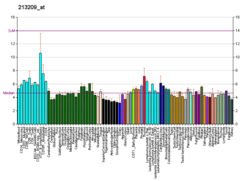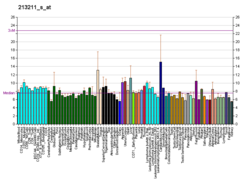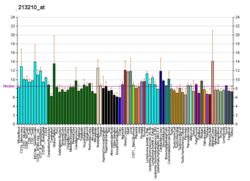Protein-coding gene in the species Homo sapiens
| TAF6L |
|---|
|
| Identifiers |
|---|
| Aliases | TAF6L, PAF65A, TATA-box binding protein associated factor 6 like |
|---|
| External IDs | OMIM: 602946; MGI: 2444957; HomoloGene: 4728; GeneCards: TAF6L; OMA:TAF6L - orthologs |
|---|
| Gene location (Human) |
|---|
 | | Chr. | Chromosome 11 (human)[1] |
|---|
| | Band | 11q12.3 | Start | 62,771,357 bp[1] |
|---|
| End | 62,787,342 bp[1] |
|---|
|
| Gene location (Mouse) |
|---|
 | | Chr. | Chromosome 19 (mouse)[2] |
|---|
| | Band | 19|19 A | Start | 8,751,851 bp[2] |
|---|
| End | 8,763,781 bp[2] |
|---|
|
| RNA expression pattern |
|---|
| Bgee | | Human | Mouse (ortholog) |
|---|
| Top expressed in | - right lobe of thyroid gland
- right lobe of liver
- apex of heart
- left lobe of thyroid gland
- anterior pituitary
- left uterine tube
- right ovary
- body of pancreas
- gastrocnemius muscle
- muscle of thigh
|
| | Top expressed in | - saccule
- tail of embryo
- otic vesicle
- spermatid
- spermatocyte
- ventricular zone
- genital tubercle
- embryo
- yolk sac
- right kidney
|
| | More reference expression data |
|
|---|
| BioGPS | 

 | | More reference expression data |
|
|---|
|
| Gene ontology |
|---|
| Molecular function | - DNA binding
- transcription coactivator activity
- protein binding
- protein heterodimerization activity
- histone acetyltransferase activity
- DNA-binding transcription factor activity
| | Cellular component | - histone deacetylase complex
- extracellular exosome
- nucleoplasm
- nucleus
- SAGA complex
- transcription factor TFIID complex
- SLIK (SAGA-like) complex
| | Biological process | - regulation of transcription by RNA polymerase II
- chromatin remodeling
- regulation of transcription, DNA-templated
- regulation of DNA-binding transcription factor activity
- histone H3 acetylation
- transcription, DNA-templated
- DNA-templated transcription, initiation
- chromatin organization
- transcription by RNA polymerase II
- transcription initiation from RNA polymerase II promoter
- positive regulation of nucleic acid-templated transcription
- RNA polymerase II preinitiation complex assembly
| | Sources:Amigo / QuickGO |
|
| Orthologs |
|---|
| Species | Human | Mouse |
|---|
| Entrez | | |
|---|
| Ensembl | | |
|---|
| UniProt | | |
|---|
| RefSeq (mRNA) | | |
|---|
| RefSeq (protein) | | |
|---|
| Location (UCSC) | Chr 11: 62.77 – 62.79 Mb | Chr 19: 8.75 – 8.76 Mb |
|---|
| PubMed search | [3] | [4] |
|---|
|
| Wikidata |
| View/Edit Human | View/Edit Mouse |
|
TAF6-like RNA polymerase II p300/CBP-associated factor-associated factor 65 kDa subunit 6L is an enzyme that in humans is encoded by the TAF6L gene.[5][6]
Function
Initiation of transcription by RNA polymerase II requires the activities of more than 70 polypeptides. The protein that coordinates these activities is transcription factor IID (TFIID), which binds to the core promoter to position the polymerase properly, serves as the scaffold for assembly of the remainder of the transcription complex, and acts as a channel for regulatory signals. TFIID is composed of the TATA-binding protein (TBP) and a group of evolutionarily conserved proteins known as TBP-associated factors or TAFs. TAFs may participate in basal transcription, serve as coactivators, function in promoter recognition or modify general transcription factors (GTFs) to facilitate complex assembly and transcription initiation. This gene encodes a protein that is a component of the PCAF histone acetylase complex and structurally similar to one of the histone-like TAFs, TAF6. The PCAF histone acetylase complex, which is composed of more than 20 polypeptides some of which are TAFs, is required for myogenic transcription and differentiation.[6]
Interactions
TAF6L has been shown to interact with TAF9[7] and Transcription initiation protein SPT3 homolog.[7]
References
- ^ a b c GRCh38: Ensembl release 89: ENSG00000162227 – Ensembl, May 2017
- ^ a b c GRCm38: Ensembl release 89: ENSMUSG00000003680 – Ensembl, May 2017
- ^ "Human PubMed Reference:". National Center for Biotechnology Information, U.S. National Library of Medicine.
- ^ "Mouse PubMed Reference:". National Center for Biotechnology Information, U.S. National Library of Medicine.
- ^ Ogryzko VV, Kotani T, Zhang X, Schiltz RL, Howard T, Yang XJ, Howard BH, Qin J, Nakatani Y (August 1998). "Histone-like TAFs within the PCAF histone acetylase complex". Cell. 94 (1): 35–44. doi:10.1016/S0092-8674(00)81219-2. PMID 9674425. S2CID 18942972.
- ^ a b "Entrez Gene: TAF6L TAF6-like RNA polymerase II, p300/CBP-associated factor (PCAF)-associated factor, 65kDa".
- ^ a b Martinez E, Palhan VB, Tjernberg A, Lymar ES, Gamper AM, Kundu TK, Chait BT, Roeder RG (October 2001). "Human STAGA complex is a chromatin-acetylating transcription coactivator that interacts with pre-mRNA splicing and DNA damage-binding factors in vivo". Mol. Cell. Biol. 21 (20): 6782–95. doi:10.1128/MCB.21.20.6782-6795.2001. PMC 99856. PMID 11564863.
Further reading
- Struhl K, Moqtaderi Z (1998). "The TAFs in the HAT". Cell. 94 (1): 1–4. doi:10.1016/S0092-8674(00)81213-1. PMID 9674419. S2CID 14869072.
- Brand M, Moggs JG, Oulad-Abdelghani M, Lejeune F, Dilworth FJ, Stevenin J, Almouzni G, Tora L (2001). "UV-damaged DNA-binding protein in the TFTC complex links DNA damage recognition to nucleosome acetylation". EMBO J. 20 (12): 3187–96. doi:10.1093/emboj/20.12.3187. PMC 150203. PMID 11406595.
- Martinez E, Palhan VB, Tjernberg A, Lymar ES, Gamper AM, Kundu TK, Chait BT, Roeder RG (2001). "Human STAGA complex is a chromatin-acetylating transcription coactivator that interacts with pre-mRNA splicing and DNA damage-binding factors in vivo". Mol. Cell. Biol. 21 (20): 6782–95. doi:10.1128/MCB.21.20.6782-6795.2001. PMC 99856. PMID 11564863.
- Cavusoglu N, Brand M, Tora L, Van Dorsselaer A (2003). "Novel subunits of the TATA binding protein free TAFII-containing transcription complex identified by matrix-assisted laser desorption/ionization-time of flight mass spectrometry following one-dimensional gel electrophoresis". Proteomics. 3 (2): 217–23. doi:10.1002/pmic.200390030. PMID 12601814. S2CID 6035986.
- Pitkänen J, Rebane A, Rowell J, Murumägi A, Ströbel P, Möll K, Saare M, Heikkilä J, Doucas V, Marx A, Peterson P (2005). "Cooperative activation of transcription by autoimmune regulator AIRE and CBP". Biochem. Biophys. Res. Commun. 333 (3): 944–53. doi:10.1016/j.bbrc.2005.05.187. PMID 15964547.
- Rual JF, Venkatesan K, Hao T, Hirozane-Kishikawa T, Dricot A, Li N, Berriz GF, Gibbons FD, Dreze M, Ayivi-Guedehoussou N, Klitgord N, Simon C, Boxem M, Milstein S, Rosenberg J, Goldberg DS, Zhang LV, Wong SL, Franklin G, Li S, Albala JS, Lim J, Fraughton C, Llamosas E, Cevik S, Bex C, Lamesch P, Sikorski RS, Vandenhaute J, Zoghbi HY, Smolyar A, Bosak S, Sequerra R, Doucette-Stamm L, Cusick ME, Hill DE, Roth FP, Vidal M (2005). "Towards a proteome-scale map of the human protein-protein interaction network". Nature. 437 (7062): 1173–8. Bibcode:2005Natur.437.1173R. doi:10.1038/nature04209. PMID 16189514. S2CID 4427026.
- Lim J, Hao T, Shaw C, Patel AJ, Szabó G, Rual JF, Fisk CJ, Li N, Smolyar A, Hill DE, Barabási AL, Vidal M, Zoghbi HY (2006). "A protein-protein interaction network for human inherited ataxias and disorders of Purkinje cell degeneration". Cell. 125 (4): 801–14. doi:10.1016/j.cell.2006.03.032. PMID 16713569. S2CID 13709685.




















